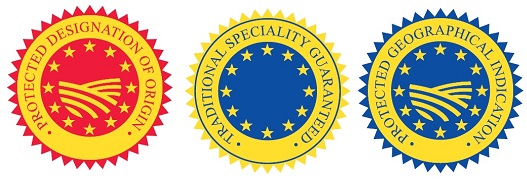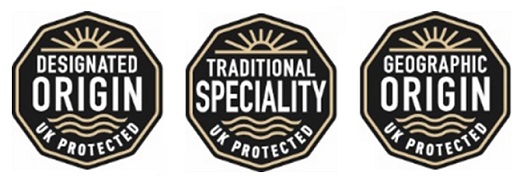|
Foodlaw-Reading
Dr David Jukes, The University of
Reading, UK
Providng access to food law since May 1996 |

|
.....  ..... ..... ..... .....  ..... .....  ..... .....  ..... ..... 
|
Last updated:
21 June, 2021
Quality Schemes and Indications for Food
Providing access to the EU and UK legislation
On this page:
- Summary - Brief details of the chronology of developments linked to this topic
- EU Legislation - Listing of Regulations covering the topic
- UK Legislation - Listing of Regulations covering the topic
|
Summary
The development of food products over many years, even generations, can provide certain products with recognisable and distinctive characteristics. These quality characteristics provide consumers with a wide range of varied products. Foods are often marketed using the name of the traditional manufacturing location and this provides added value to the local agricultural and food industry. Often these products are manufactured using traditional skills in artisanal or small businesses. However, as the use of the designation is seen to add value to a product, larger manufacturers based elsewhere may be able to reproduce some of the characteristics of the products and could potentially market their versions using the traditional names - and hence damage the traditional small local manufacturers. To seek to prevent this from happening, the Community moved to create a legislative framework to protect traditional products and their designations.
It was in 1992 that the Community adopted its first controls.
Council Regulation 2081/92 on the protection of geographical indications and designations of origin for agricultural products and foodstuffs
created a framework for the adoption of protected designations of origin (PDO) or protected geographical indications (PGI). Applications could be made to the Commission and, after appropriate checks, it would publish the protected name in a register along with the conditions for its use. At the same time, a second regulation, Regulation 2082/92 on certificates of specific character for agricultural products and foodstuffs, provided for the registration of products which were not directly linked to a geographical area but which had certain characteristics. Both Regulations were updated in 2006 by Regulation 509/2006 on agricultural products and foodstuffs as traditional specialities guaranteed and Regulation 510/2006 on the protection of geographical indications and designations of origin for agricultural products and foodstuffs. Regulation 509/2006 changed the terminology of Regulation 2082/92 from a Certificate of Specific Character to Traditional Speciality Guaranteed (TSG). The changes also took into account issues which had been raised by third countries. In 2012, both schemes were combined with the adoption of Regulation 1151/2012 on quality schemes for agricultural products and foodstuffs.
Supporting the above regulations, logos have been developed to give consumers confidence in the products which have been approved and registered. These were first legally defined in Regulations 1898/2006 (for PGIs and PDOs) and 1216/2007 (for TSGs) but are now specified in Regulation 664/2014.
Based on the more general provisions of Regulation 1151/2012, similar controls exist to provide protection to mountain products (now in Regulation 665/2014). Another set of controls, including special logos, has been established to support agriculture in the outermost regions of the Union - details can be found in Regulations 228/2013 and 179/2014 (not on this page - see the Commission's page: Regulations on products of outermost regions).
There are additional schemes for the wine sector and spirit drinks. These are not covered on this page. See the Commission's pages: Regulations on wine,
Regulations on aromatised wines and
Regulations on spirit drinks.
For the Commission's page on this topic, see: Quality Labels.
EU Law

Framework Regulation:
- Regulation (EU) No 1151/2012 of the European Parliament and of the Council of 21 November 2012 on quality schemes for agricultural products and foodstuffs (OJ L343, 14.12.2012, page 1) as amended by:
- Regulation (EU) 2017/625 of the European Parliament and of the Council of 15 March 2017 on official controls and other official activities performed to ensure the application of food and feed law, rules on animal health and welfare, plant health and plant protection products, amending .... (OJ L95, 7.4.2017, page 1)
Supporting Measures:
- Commission Delegated Regulation (EU) No 664/2014 of 18 December 2013 supplementing Regulation (EU) No 1151/2012 of the European Parliament and of the Council with regard to the establishment of the Union symbols for protected designations of origin, protected geographical indications and traditional specialities guaranteed and with regard to certain rules on sourcing, certain procedural rules and certain additional transitional rules (OJ L179, 19.6.2014, page 17)
- Commission Delegated Regulation (EU) No 665/2014 of 11 March 2014 supplementing Regulation (EU) No 1151/2012 of the European Parliament and of the Council with regard to conditions of use of the optional quality term ‘mountain product’ (OJ L179, 19.6.2014, page 23)
- Commission Implementing Regulation (EU) No 668/2014 of 13 June 2014 laying down rules for the application of Regulation (EU) No 1151/2012 of the European Parliament and of the Council on quality schemes for agricultural products and foodstuffs (OJ L179, 19.6.2014, page 36) as corrected by:
See also:
- Commission Communication — Guidelines on the labelling of foodstuffs using protected designations of origin (PDOs) or protected geographical indications (PGIs) as ingredients (OJ C341, 16.12.2010, page 3)
- Commission Communication — EU best practice guidelines for voluntary certification schemes for agricultural products and foodstuffs (OJ C341, 16.12.2010, page 5)
Database:
- eAmbrosia – the EU geographical indications register
- GIview: Search for Geographical Indications across the European Union and beyond
UK Legislation
Brexit: Prior to the IP Completion Day (31 December 2020), the legal requirements given in the EU Regulations listed above still applied to the UK. Since IP Completion Day, the EU Regulations above have been incorporated into UK legislation but with amendments to correct deficiencies. Information on this is given below. For more details of the process of incorporating EU legislation into UK law, see the separate page: UK Food Law: EU Legislation as Amended for the UK. Provisions for the enforcement of the controls (originally the EU Regulations but now as amended) have been provided in the UK Regulations listed below. For Northern Ireland, EU rules still apply.

Note: These symbols can be found in a UK amendment to EU Regulation 664/2014 - see the UK Regulation: 2020, No. 1637
Guidance (provided by Department for Environment, Food & Rural Affairs):
EU Legislation amended for application in the UK: with links to legislation.gov.uk
- Regulation (EU) No 1151/2012 of the European Parliament and of the Council on quality schemes for agricultural products and foodstuffs as amended by:
- Food and Drink, Veterinary Medicines and Residues (Amendment etc.) (EU Exit) Regulations 2019 (SI 2019, No. 865)
as amended by:
- Veterinary Medicines and Residues (Amendment) (EU Exit) Regulations 2020 (SI 2020, No. 1461)
- Agricultural Products, Food and Drink (Amendment etc.) (EU Exit) Regulations 2020 (SI 2020, No. 1637) as amended by:
- Agricultural Products, Food and Drink (Amendment) (EU Exit) Regulations 2020 (SI 2020, No. 1661)
- Agricultural Products, Food and Drink (Amendment etc.) (EU Exit) Regulations 2020 (SI 2020, No. 1637) as amended by:
- Agricultural Products, Food and Drink (Amendment) (EU Exit) Regulations 2020 (SI 2020, No. 1661)
- Agricultural Products, Food and Drink (Amendment) (EU Exit) Regulations 2020 (SI 2020, No. 1661)
- Commission Delegated Regulation (EU) No 664/2014 supplementing Regulation (EU) No 1151/2012 of the European Parliament and of the Council with regard to the establishment of the Union symbols for protected designations of origin, protected geographical indications and traditional specialities guaranteed ... as amended by:
- Food and Drink, Veterinary Medicines and Residues (Amendment etc.) (EU Exit) Regulations 2019 (SI 2019, No. 865) as amended by:
- Veterinary Medicines and Residues (Amendment) (EU Exit) Regulations 2020 (SI 2020, No. 1461)
- Agricultural Products, Food and Drink (Amendment etc.) (EU Exit) Regulations 2020 (SI 2020, No. 1637) as amended by:
- Agricultural Products, Food and Drink (Amendment) (EU Exit) Regulations 2020 (SI 2020, No. 1661)
- Agricultural Products, Food and Drink (Amendment etc.) (EU Exit) Regulations 2020 (SI 2020, No. 1637) as amended by:
- Agricultural Products, Food and Drink (Amendment) (EU Exit) Regulations 2020 (SI 2020, No. 1661)
- Commission Delegated Regulation (EU) No 665/2014 supplementing Regulation (EU) No 1151/2012 of the European Parliament and of the Council with regard to conditions of use of the optional quality term ‘mountain product' as amended by:
- Food and Drink, Veterinary Medicines and Residues (Amendment etc.) (EU Exit) Regulations 2019 (SI 2019, No. 865) as amended by:
- Veterinary Medicines and Residues (Amendment) (EU Exit) Regulations 2020 (SI 2020, No. 1461)
- Agricultural Products, Food and Drink (Amendment etc.) (EU Exit) Regulations 2020 (SI 2020, No. 1637) as amended by:
- Agricultural Products, Food and Drink (Amendment) (EU Exit) Regulations 2020 (SI 2020, No. 1661)
- Commission Implementing Regulation (EU) No 668/2014 laying down rules for the application of Regulation (EU) No 1151/2012 of the European Parliament and of the Council on quality schemes for agricultural products and foodstuffs as amended by:
- Food and Drink, Veterinary Medicines and Residues (Amendment etc.) (EU Exit) Regulations 2019 (SI 2019, No. 865) as amended by:
- Veterinary Medicines and Residues (Amendment) (EU Exit) Regulations 2020 (SI 2020, No. 1461)
- Agricultural Products, Food and Drink (Amendment etc.) (EU Exit) Regulations 2020 (SI 2020, No. 1637) as amended by:
- Agricultural Products, Food and Drink (Amendment) (EU Exit) Regulations 2020 (SI 2020, No. 1661)
- Agricultural Products, Food and Drink (Amendment etc.) (EU Exit) Regulations 2020 (SI 2020, No. 1637) as amended by:
- Agricultural Products, Food and Drink (Amendment) (EU Exit) Regulations 2020 (SI 2020, No. 1661)
- Agricultural Products, Food and Drink (Amendment) (EU Exit) Regulations 2020 (SI 2020, No. 1661)
Enforcement
The enforcement of the controls are provided for the whole of the United Kingdom by a single UK Statutory Instrument:
- Quality Schemes (Agricultural Products and Foodstuffs) Regulations 2018 (SI 2018, No. 1275) as amended by:
- Food and Drink, Veterinary Medicines and Residues (Amendment etc.) (EU Exit) Regulations 2019 (SI 2019, No. 865) as amended by:
- Veterinary Medicines and Residues (Amendment) (EU Exit) Regulations 2020 (SI 2020, No. 1461)
- Agricultural Products, Food and Drink (Amendment etc.) (EU Exit) Regulations 2020 (SI 2020, No. 1637) as amended by:
- Agricultural Products, Food and Drink (Amendment) (EU Exit) Regulations 2020 (SI 2020, No. 1661)
- Official Controls (Animals, Feed and Food, Plant Health Fees etc.) Regulations 2019 (SI 2019, No. 1488)
- Agricultural Products, Food and Drink (Amendment etc.) (EU Exit) Regulations 2020 (SI 2020, No. 1637) [Note: This provides different amendments for E/W/S compared to those for NI] as amended by:
- Agricultural Products, Food and Drink (Amendment) (EU Exit) Regulations 2020 (SI 2020, No. 1661)
UK Register
This page was first provided on 8 January 2021
To go to main Foodlaw-Reading
Index page, click here.
![]()

